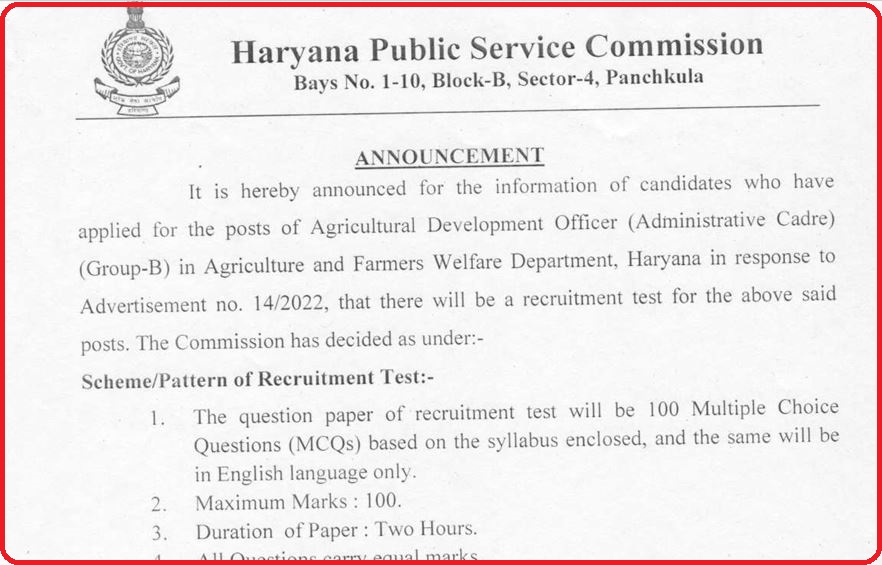HPSC ADO Syllabus 2022 Check Exam Pattern Here: Haryana Public Service Commission has released Agriculture Development Officer Exam Syllabus & Pattern available on official site. Candidates who Search for Haryana PSC ADO Syllabus and Exam Pattern can visit the official web Portal @ hpsc.gov.in. Aspirants can check out this article to know the Exam Pattern & Syllabus for HPSC Agriculture Development Officer.

HPSC ADO Syllabus 2022 – Overview
| HPSC ADO Syllabus & Exam Pattern 2022 | |
| Organization Name | Haryana Public Service Commission (HPSC) |
| Post Name | Agriculture Development Officer (ADO) |
| Advertisement no | 14/ 2022 |
| Category | Syllabus |
| Job Location | Haryana |
| Official Site | hpsc.gov.in |
HPSC ADO Exam Pattern 2022
- Each Answer get One mark. In total 100 Marks.
- The duration of the Exam is Two hours.
- Each wrong answer deducts 0.25 marks.
- The Total questions were 100 asked.
- The Question type will be in Multiple Choice Questions.
- No candidate shall be called for the interview viva-voce unless he/she obtains at least 50% Qualifying marks in the recruitment test unreserved category and 45% Marks for all reserved category.
HPSC Agricultural Development Officer Syllabus 2022
- Ecology and its relevance to man, natural resources, their sustainable management and conservation Physical and social environment as factors of crop distribution and production. Agro ecology; cropping pattern as indicators of environments. Environmental pollution and associated hazards to crops, animals, and humans. Climate change-international conventions and global initiatives. Greenhouse effect and global warming Advance tools for ecosystem analysis-Remote sensing (Rs) and Geographic Information Systems (GIS).
- Cropping patterns in different agro-climatic zones of the country’ Impact of high yielding and short-duration varieties on shifts in cropping patterns Concepts of various cropping, and farming systems. Organic and Precision farming Package of practices for the production of important cereals, pulses, oil seeds, fibers, sugar, and commercial and fodder crops.
- Important features, and scope of various types of forestry plantations such as social forestry, agro-forestry, and natural forests: Propagation of forest plants. Forest products. Agro_forestry and value addition. Conservation of forest flora and fauna.
- Weeds, their characteristics, dissemination, and association with various crops; their multiplications; cultural, biological, and chemical control of weeds.
- Soil-physical, chemical, and biological properties Processes and factors of soil formation. Soils of India. Mineral and organic constituents of soils and their role in maintaining soil productivity. Essential plant nutrients and other beneficial elements in soils and plants. Principles of soil fertility, soil testing and fertilizer recommendations, integrated nutrient management Biofertilizers’ Losses of nitrogen in the soil, nitrogen-use efficiency in submerged rice soils, nitrogen fixation in soils. Efficient phosphorus and potassium use. Problem soils and their reclamation. Soil factors affecting greenhouse gas emission.
- Soil conservation, integrated watershed management. Soil erosion and its
management. Dry land agriculture and its problems. Technology for stabilizing agriculture production in rainfed areas. - Water use efficiency in relation to crop production, criteria for scheduling Irrigations, ways, and means of reducing run-off Losses of irrigation water’ Rai; water harvesting. Drip and sprinkler irrigation. Drainage of water_logged soils, quality of irrigation water, the effect of industrial effluents on soil, and water pollution. Irrigation projects in India.
- Farm management, scope, importance and characteristics, farm planning Optimum resource use and budgeting. Economics of different types of farming systems. Marketing management strategies for development, market intelligence. Price fluctuations and their cost; the role of co-operatives in agricultural economy; types and systems of farming and factors affecting their Agricultural price policy. Crop insurance.
- Agricultural extension, its importance, and role, methods of evaluation of extension programs, socio-economic survey and status of big, small, and marginal farmers and landless agricultural laborers; Training programs for extension workers. Role of Krishi Vigyan Kendra’s (KVK) in the dissemination of Agricultural technologies. Non-Government Organization (NGO) and self-help group approach for rural development.
- Cell structure, function, and cell cycle. Synthesis, structure, and function of genetic material. Laws of heredity. Chromosome structure, chromosomal aberrations, linkage and cross-over, and their significance in recombination breeding. Polyploidy, euploids, and aneuploids. Mutation-and their role in crop improvement. Heritability, sterility and incompatibility, classification and their application in crop improvement.
- History of plant breeding. Modes of reproduction, selfing, and crossing techniques. Origin, evolution, and domestication of crop plants, the center of origin. law of homologous series, crop genetic resources-conservation, and utilization. Application of principles of plant breeding, improvement of crop plants. Molecular markers and their application in plant improvement. Pure-line selection, pedigree, mass, and recurrent selections, combining ability, and its significance in plant breeding. Heterosis and its exploitation. Somatic Juridization Breeding for disease and pest resistance. Role of interspecific and lifted crop plants.
- Seed production and processing technologies. Seed certification, Seed testing and storage. DNA finger printing and seed registration. Role of public and private sectors in seed production, and marketing. Intellectual Property Rights (IPR) issues, WTO issues, and its impact on Agriculture.
- Principles of Plant Physiology with reference to plant nutrition, absorption, translocation, and metabolism of nutrients. Soil-water-plant relationship. Enzymes and plant pigments; photosynthesis-modern concepts and factors affecting the process, aerobic and anaerobic respiration; C3, C4, and CAM mechanisms. Carbohydrate, protein, and fat metabolism. Growth and development; photoperiodism and vernalization. Plant growth substances and their role in crop production. Physiology of seed development and germination; dormancy. Stress-physiology-draught, salt, and water stress.
- Major fruits, plantation crops, vegetables, spices, and flower crops. Package practices of major horticultural crops. Protected cultivation and high-tech horticulture. Post-harvest technology and value addition of fruits and vegetables, Landscaping, and commercial floriculture. Medicinal and aromatic plants. Role of fruits and vegetables in human nutrition.
HPSC Agricultural Development Officer Syllabus 2022

